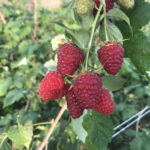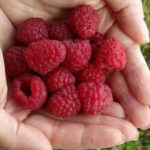Raspberry variety Indian summer
The repair raspberry has been known to gardeners all over the world for over 200 years. Its distinctive feature is the possibility of fruiting not only on two-year-old shoots, like in ordinary varieties, but also on annual ones. This fact has many benefits. In particular, it becomes possible to cultivate a crop in a one-year cycle, removing all shoots from the bush after fruiting, which, in turn, significantly improves the phytosanitary state of plantations, and the frost resistance of bushes completely covered with snow becomes very high. In addition, the late summer harvests of remontant varieties, in contrast to the usual ones, turn out to be extended in terms of ripening time, and therefore one can feast on fresh raspberries for one and a half to two months. And, finally, plants of this type, as a rule, do not differ in the activity of growth of root suckers, and develop in a strictly allocated space for them.
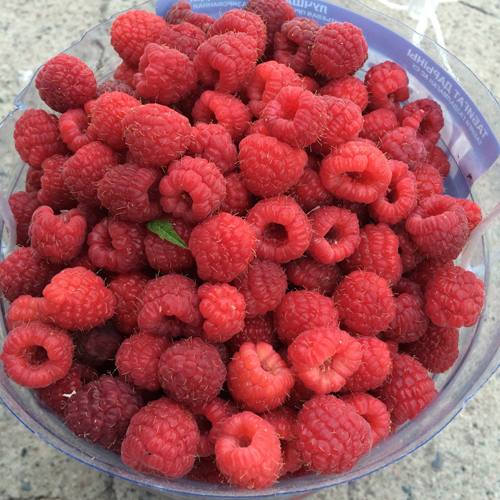
However, despite such an abundance of positive qualities, the widespread cultivation of remontant raspberries in our country began relatively recently. The reasons for this were more than prosaic - until the 70s of the last century, we simply did not have varieties acclimatized to the conditions of the middle zone that could give any significant harvest before the autumn frosts that occur in the central regions in mid-September. All foreign varieties turned out to be late ripening and were suitable for cultivation only in the extreme south.
Ivan Kazakov, a young researcher at that time, undertook to correct this gap, was a researcher at the All-Russian Institute of Selection and Technology for Horticulture and Nursery (VSTISP). The work was carried out directly on the basis of the Kokinsky support point of the Institute, located in the Bryansk region. Subsequently, this institution gained fame as a leading national center for breeding remontant varieties, and Ivan Vasilyevich Kazakov became a world-famous scientist, Honored Scientist of the Russian Federation, Academician of the Russian Academy of Agricultural Sciences. The main task that the breeder set himself was to obtain new high-quality forms that can ripen with a frost-free period of about 130 days and a sum of active temperatures up to 2000 ° C.
The first variety obtained by the researcher under the new program back in 1973 was Indian Summer. By today's standards, this variety seems far from ideal, because its yield potential in the central regions was only half revealed. However, at that time it was a real breakthrough, because foreign varieties in the same conditions had time to ripen only by 15-20%. Ivan Vasilyevich managed to achieve such a result as a result of complex hybridization, during which the American remontant variety Sentyabrsky was crossed with the early-flowering working form No. 12−77, whose parents were Kostinbrodskaya and Kuzmin's news.
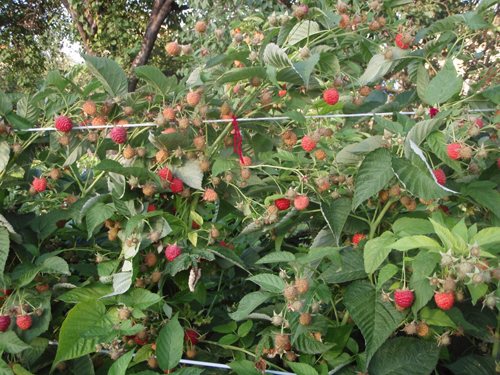
In addition to the relatively short growing season, Indian Summer was characterized by good gastronomic and aesthetic qualities of the fruit, as well as resistance to some diseases. Despite this, the form entered the state variety testing only in 1989, and completed it six years later, being, as a result, included in the State Register of Breeding Achievements of the Russian Federation. Recommended for cultivation in the North-West, Central and North-Caucasian regions, but at present it is distributed only in the south, because in the middle lane turned out to be ousted by new, even more early ripening varieties.
Agrobiological properties
The growth force of the bush is moderate, its height does not exceed one and a half meters. The appearance of plants is slightly spreading due to erect shoots of medium thickness. Despite this, the variety requires the installation of supports or the arrangement of the trellis, becauseunder the weight of the crop, especially in windy conditions, loose stems can be seriously damaged. Replacement shoots are formed at a moderate intensity, in number of the order of 10-15 / meter. On young shoots, the greenish color is complemented by a pink anthocyanin tint, and an intense waxy bloom is noticeable on the surface. In the second year of life, the color of the stem changes to light brown. The spine of the shoots is relatively high, and this circumstance does not add convenience when caring for plants and harvesting. The spines are straight, significant in size, and also quite tough. Leaves are complex, grow not too large and consist of three or five simple leaves, connected by a petiole of moderate length. The leaf blades are rich green, have the shape of an elongated oval with a pointed end, the surface is smooth or barely wrinkled, the leaf profile is slightly twisted. The denticles along the edges of the leaves are very small. Fruit twigs begin to appear at a height of 60–70 cm from the soil surface, and therefore the fruit zone is concentrated on the upper half of the stems. Laterals strongly branch, which is why they are literally covered with ovaries. Root shoots do not develop very actively, which frees the gardener from significant efforts to keep row spacings clean. At the same time, reproduction will also not be fast, due to a lack of planting material.
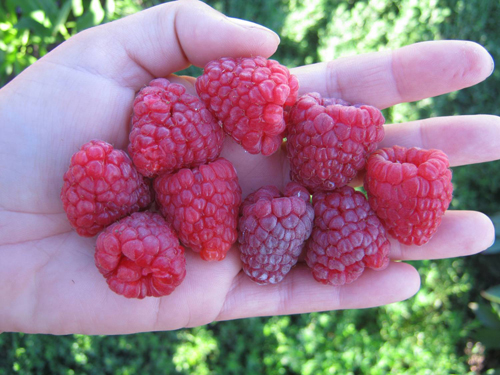
Flowers on the shoots of the second year of life appear in May, on annuals - in July. In the first case, flowering occurs relatively amicably, and in the second it is stretched, and continues, as more and more flowers appear, until the beginning of autumn. The fruits ripen in June and August-September, respectively. In a two-year cycle, it is advisable to grow our heroine only in the north, where she is not able to fully show her remontance. We are talking about the central regions of the European part of our country, the south of Western Siberia or the Urals, in which the potential of late summer fruiting in the variety before the onset of frost is revealed less than 50%. In regions provided with warmth, where this percentage is much higher, young shoots that bear fruit are not left in the second year, completely removing all aboveground parts of the bush in the fall. This makes it possible to achieve active growth of annual stems in spring, accelerating the appearance of laterals on them, flowering and the beginning of fruiting. Ideally, with a long warm autumn, up to one and a half kilograms of berries can be harvested from a bush, however, frosts regularly make adjustments to this figure. Because of this, under production conditions, the yield is not too high - 40-50 c / ha, significantly inferior to more modern forms. Ripe fruits are well separated from the stalk, without creating problems during harvesting. The Indian Summer variety is even considered suitable for mechanized harvesting.
The berries grow medium in size, about 17 mm high, 18 mm in diameter, and weighing about 2-3 grams. They have the shape of a truncated cone and slightly pubescent, their color is deep red. The pulp of the fruit is quite tender, juicy with a pleasant sweet and sour taste, but the aroma typical of the culture is not very pronounced. The seeds are hard, but small, 25-30 pieces per berry. In general, the quality of this raspberry is characterized as good. Tasting marks are 4.5 points. The mass fraction of dry matter in the pulp of fruits exceeds 10%, the amount of sugars ranges from 7-8%, the titratable acidity is about 1.7%. The content of anthocyanins, which determine the color intensity of raspberries, is about 130 mg per 100 grams of berries, vitamin C - 27-30 mg, vitamin P - 40-45 mg.
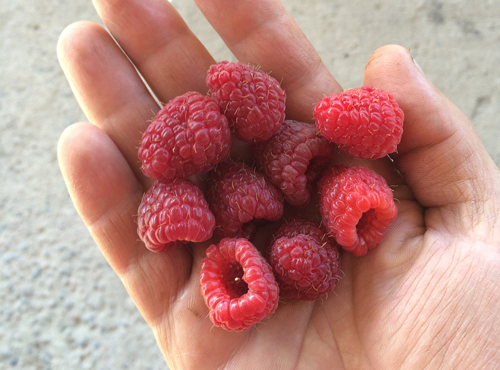
The directions of use of the harvested crop are very diverse. This raspberry tastes very good when consumed fresh. It is in demand among buyers in the market, but it does not cause much interest among farmers due to its relatively low yield. In addition, the tenderness of the berries creates difficulties with their transportability, because raspberries can wrinkle easily and start flowing quickly. To a greater extent, the variety is suitable for amateurs who cultivate crops in their personal plots for their own needs.Suitability for long-distance transportation does not play a significant role for them, but high gastronomic characteristics are the determining factor. Indian Summer also shows itself well when processed for various home preservation. Compotes from it have a richness and fullness of taste, a pleasant aroma, and an intense color that does not fade during storage. The jam also turns out to be excellent, with a harmonious ratio of acid and sugar, bright aroma and memorable taste. Berries, subject to processing technology, keep their shape well and do not boil over.
In economic terms, our heroine looks more than worthy. When cultivating, it does not require the creation of special conditions for itself, demonstrating the ability to grow and develop normally on many types of soils with various levels of fertility and texture. The placement of raspberries is limited only on saline and strongly acidic soils that require preliminary chemical reclamation. In relation to common diseases and pests, the form shows good resistance to curl and gray mold, but remains susceptible to purple spot, powdery mildew and spider mites. Indian summer does not have high indicators of drought resistance and heat resistance, and responds well to regular watering in order to maintain an optimal soil water balance. Winter hardiness with a one-year cultivation option is very good, and plants completely covered with snow can withstand the winter cold without any problems.
Agrotechnical features
The specificity of cultivation of this variety is associated, first of all, with its remontability and a relatively long growing season, which requires, accordingly, an increased supply of heat in comparison with other varieties. In this regard, special attention should be paid to the selection of the optimal place for placing the raspberry tree. The author of Indian Summer, Professor Kazakov, recommended allocating the most sunlit areas under it, preferably on gentle slopes of warm exposures, where the sum of active temperatures turns out to be several hundred degrees higher than on the plain. Good results are also shown by the placement of bushes in a wall culture on the south side of various buildings, dense fences and hedges. Unsuitable for this raspberry are both hills, from where snow is often blown off in winter, and lowlands, closed on all sides, where cold air accumulates, and the soil often turns out to be excessively damp or even swampy due to the level of groundwater occurrence close to the surface.
The soil under the raspberry tree is prepared by deep loosening and removing the rhizomes of malicious perennial weeds. Planting is carried out in early spring or autumn, after leaf fall, in pre-prepared pits of sufficient size, filled with high doses of organic and mineral fertilizers. A distance of at least 1.5 m is maintained between the rows, and 60-70 cm between plants in a row.
On fruiting plantations, the cleanliness of the row spacings is maintained, the bushes are watered and fed, the necessary plant protection measures are taken, the growing shoots are tied to the trellis, and after the harvest and the onset of the first frost, all stems are removed.




